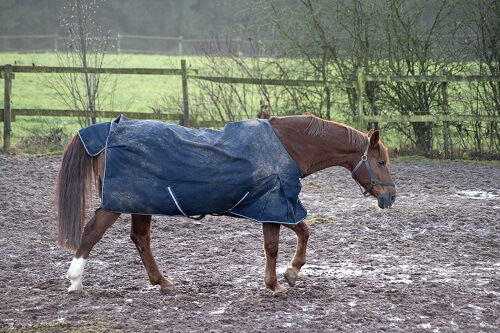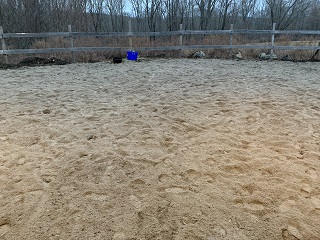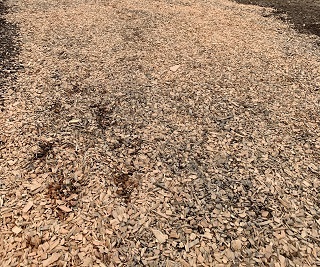Barn Management: Over All This Mud?

To say we’ve had a wet winter is an understatement. With rain comes mud, followed by freezing temperatures which inevitably harden the hoof-trodden earth into a veritable moonscape of dangerous divots that strike fear into the hearts of a horse owner.
In my barn management battle against the omnipresent mud, after soliciting advice from horse contacts, doing a considerable amount of online research, and instituting some good old-fashioned trial-and-error, we finally arrived at a reasonably economical solution that seems to be working quite well. Here are our key takeaways from this ordeal:
- We used the front-end loader of our tractor to remove the top layer of saturated earth from the area most heavily prone to mud. For us, it was the small paddock immediately outside our barn which is where the horses congregate to eat hay. We scooped out the mud, leaving the firmer ground beneath the muddy surface.
- We bought a tractor attachment called a subsoiler ($200 at Tractor Supply). The subsoiler works by breaking up hard-packed soil about a foot below the surface, thereby helping to drain away water that otherwise gets trapped as standing water. In areas with clay, compact soil can be a particular challenge as the rain isn’t able to soak easily into the ground. The subsoiler is very quick and easy to use, and while it’s definitely not a permanent solution for diverting water (like French drains, for example), it seemed to help. The most time-consuming part was merely covering up the resulting furrow so that it wasn’t dangerous for a horse to walk on.
- We then covered the paddock area with stone dust, at a thickness of about 3-4 inches. When we called to order the stone dust from our local landscaping company, I simply gave them the dimensions of the paddock and my desired depth, and they were able to calculate the number of square yards of stone dust we would need. We raked the stone dust so that it was flat, level and smooth. The stone dust drains nicely, and even when wet, holds up incredibly well against deep hoof holes. On a warmer day, it can be helpful to rake it smooth, but otherwise does not take much in the way of upkeep.

- In areas prone to greater traffic and poorer traction, we’ve added wood chips (also several-inches thick). For us, these areas have been the hills and entrances to paddocks where the horses tend to congregate. We’ve found that this has helped prevent the development of mud in these areas. One important note: since several kinds of wood are toxic to horses, it’s critical to source wood chips that you can verify are not comprised of any black walnut, cherry, maple or yew trees. The wood chips will eventually decompose so you’ll need to replace them about 1-2x per year.

Mud is certainly the bane of a barn manager’s existence, but there is some hope for winning the war. In our case, it has been well-worth the additional cost and labor to provide great horse care.






